University Report: Analyzing CRM Factors and their Impact on Business
VerifiedAdded on 2020/03/07
|12
|2017
|113
Report
AI Summary
This report provides a comprehensive analysis of the factors that contribute to effective Customer Relationship Management (CRM). It explores the significance of establishing strong customer relationships for business success, emphasizing that customers are the real asset. The research utilizes a mixed-methods approach, combining qualitative and quantitative methodologies, including surveys and interviews with staff, clients, and administrators. Key factors examined include the role of information technology, management commitment, human resources, CRM knowledge, and organizational culture. The report outlines research questions, objectives, and hypotheses, supported by a literature review and a conceptual model. The expected outcomes suggest the implementation of CRM in both domestic and foreign firms, advocating for cost-benefit analysis through human resource training and the application of information technology. The report references various academic sources to support its findings.
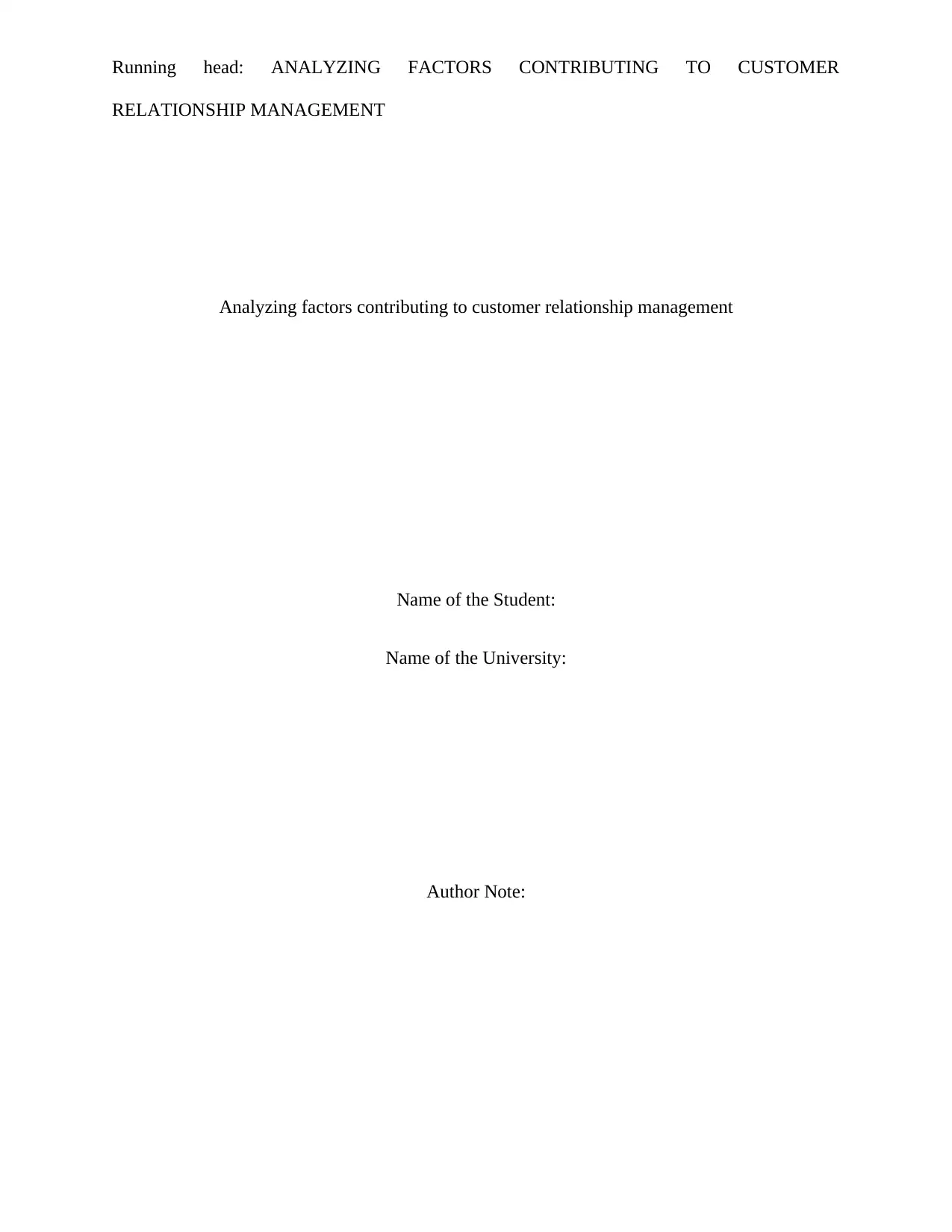
Running head: ANALYZING FACTORS CONTRIBUTING TO CUSTOMER
RELATIONSHIP MANAGEMENT
Analyzing factors contributing to customer relationship management
Name of the Student:
Name of the University:
Author Note:
RELATIONSHIP MANAGEMENT
Analyzing factors contributing to customer relationship management
Name of the Student:
Name of the University:
Author Note:
Paraphrase This Document
Need a fresh take? Get an instant paraphrase of this document with our AI Paraphraser
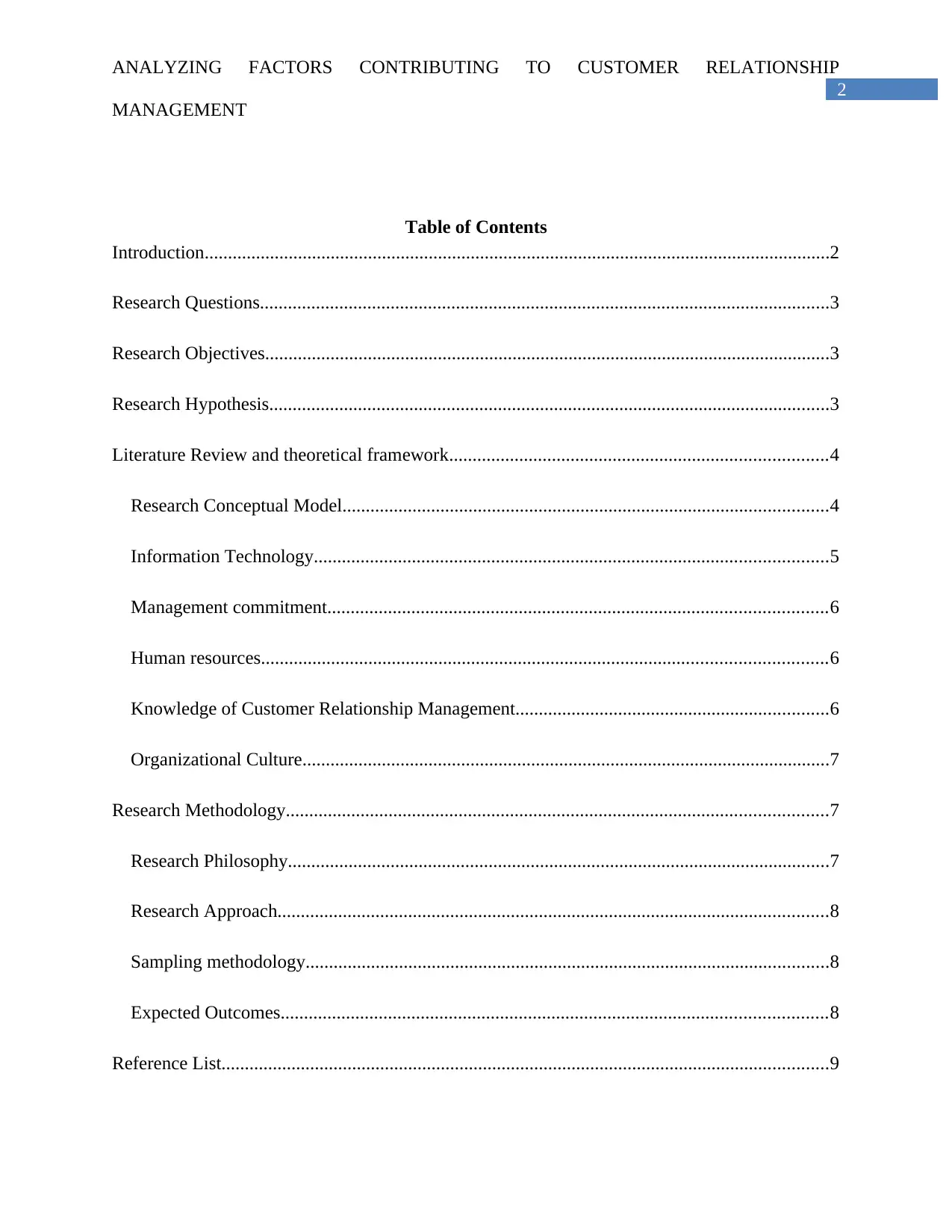
2
ANALYZING FACTORS CONTRIBUTING TO CUSTOMER RELATIONSHIP
MANAGEMENT
Table of Contents
Introduction......................................................................................................................................2
Research Questions..........................................................................................................................3
Research Objectives.........................................................................................................................3
Research Hypothesis........................................................................................................................3
Literature Review and theoretical framework.................................................................................4
Research Conceptual Model........................................................................................................4
Information Technology..............................................................................................................5
Management commitment...........................................................................................................6
Human resources.........................................................................................................................6
Knowledge of Customer Relationship Management...................................................................6
Organizational Culture.................................................................................................................7
Research Methodology....................................................................................................................7
Research Philosophy....................................................................................................................7
Research Approach......................................................................................................................8
Sampling methodology................................................................................................................8
Expected Outcomes.....................................................................................................................8
Reference List..................................................................................................................................9
ANALYZING FACTORS CONTRIBUTING TO CUSTOMER RELATIONSHIP
MANAGEMENT
Table of Contents
Introduction......................................................................................................................................2
Research Questions..........................................................................................................................3
Research Objectives.........................................................................................................................3
Research Hypothesis........................................................................................................................3
Literature Review and theoretical framework.................................................................................4
Research Conceptual Model........................................................................................................4
Information Technology..............................................................................................................5
Management commitment...........................................................................................................6
Human resources.........................................................................................................................6
Knowledge of Customer Relationship Management...................................................................6
Organizational Culture.................................................................................................................7
Research Methodology....................................................................................................................7
Research Philosophy....................................................................................................................7
Research Approach......................................................................................................................8
Sampling methodology................................................................................................................8
Expected Outcomes.....................................................................................................................8
Reference List..................................................................................................................................9
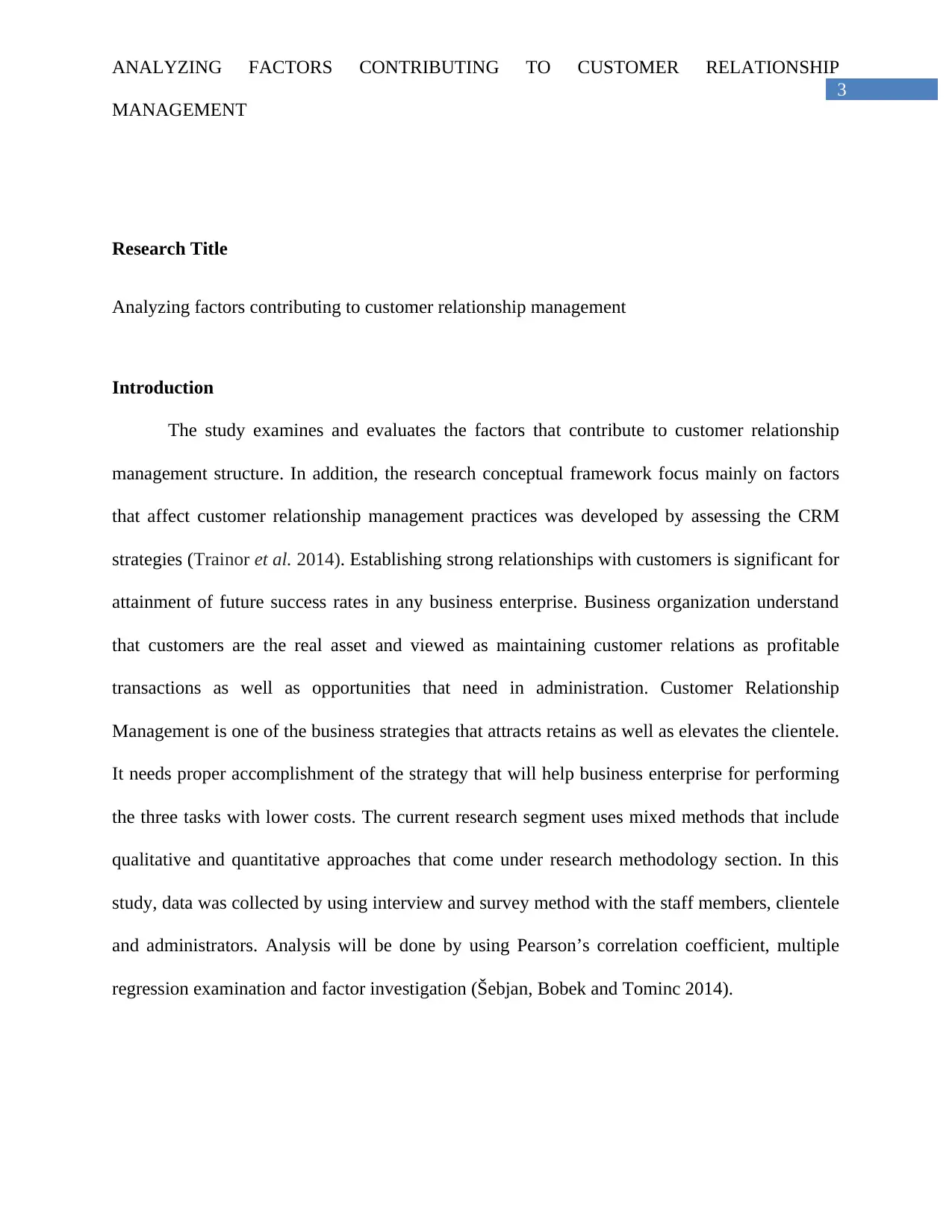
3
ANALYZING FACTORS CONTRIBUTING TO CUSTOMER RELATIONSHIP
MANAGEMENT
Research Title
Analyzing factors contributing to customer relationship management
Introduction
The study examines and evaluates the factors that contribute to customer relationship
management structure. In addition, the research conceptual framework focus mainly on factors
that affect customer relationship management practices was developed by assessing the CRM
strategies (Trainor et al. 2014). Establishing strong relationships with customers is significant for
attainment of future success rates in any business enterprise. Business organization understand
that customers are the real asset and viewed as maintaining customer relations as profitable
transactions as well as opportunities that need in administration. Customer Relationship
Management is one of the business strategies that attracts retains as well as elevates the clientele.
It needs proper accomplishment of the strategy that will help business enterprise for performing
the three tasks with lower costs. The current research segment uses mixed methods that include
qualitative and quantitative approaches that come under research methodology section. In this
study, data was collected by using interview and survey method with the staff members, clientele
and administrators. Analysis will be done by using Pearson’s correlation coefficient, multiple
regression examination and factor investigation (Šebjan, Bobek and Tominc 2014).
ANALYZING FACTORS CONTRIBUTING TO CUSTOMER RELATIONSHIP
MANAGEMENT
Research Title
Analyzing factors contributing to customer relationship management
Introduction
The study examines and evaluates the factors that contribute to customer relationship
management structure. In addition, the research conceptual framework focus mainly on factors
that affect customer relationship management practices was developed by assessing the CRM
strategies (Trainor et al. 2014). Establishing strong relationships with customers is significant for
attainment of future success rates in any business enterprise. Business organization understand
that customers are the real asset and viewed as maintaining customer relations as profitable
transactions as well as opportunities that need in administration. Customer Relationship
Management is one of the business strategies that attracts retains as well as elevates the clientele.
It needs proper accomplishment of the strategy that will help business enterprise for performing
the three tasks with lower costs. The current research segment uses mixed methods that include
qualitative and quantitative approaches that come under research methodology section. In this
study, data was collected by using interview and survey method with the staff members, clientele
and administrators. Analysis will be done by using Pearson’s correlation coefficient, multiple
regression examination and factor investigation (Šebjan, Bobek and Tominc 2014).
⊘ This is a preview!⊘
Do you want full access?
Subscribe today to unlock all pages.

Trusted by 1+ million students worldwide
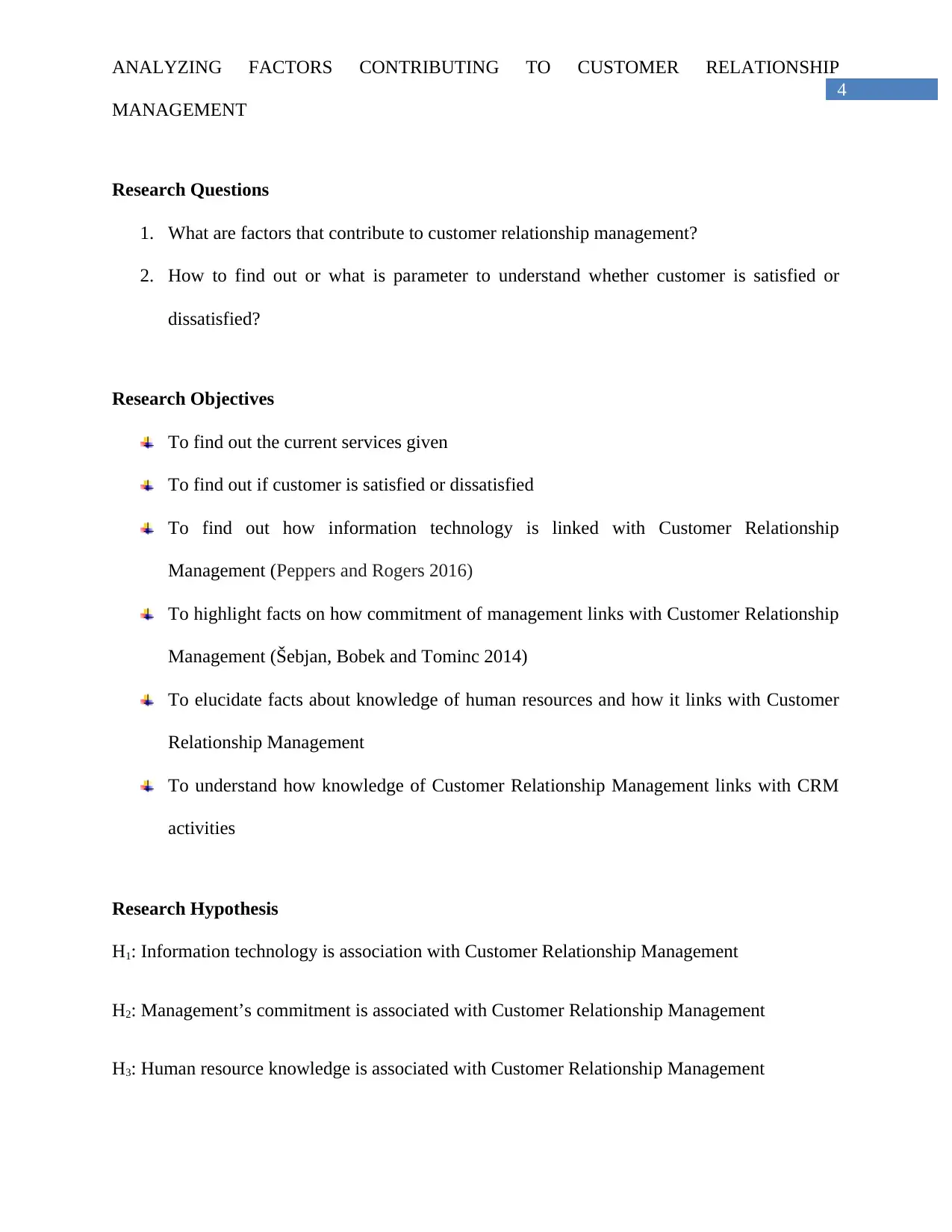
4
ANALYZING FACTORS CONTRIBUTING TO CUSTOMER RELATIONSHIP
MANAGEMENT
Research Questions
1. What are factors that contribute to customer relationship management?
2. How to find out or what is parameter to understand whether customer is satisfied or
dissatisfied?
Research Objectives
To find out the current services given
To find out if customer is satisfied or dissatisfied
To find out how information technology is linked with Customer Relationship
Management (Peppers and Rogers 2016)
To highlight facts on how commitment of management links with Customer Relationship
Management (Šebjan, Bobek and Tominc 2014)
To elucidate facts about knowledge of human resources and how it links with Customer
Relationship Management
To understand how knowledge of Customer Relationship Management links with CRM
activities
Research Hypothesis
H1: Information technology is association with Customer Relationship Management
H2: Management’s commitment is associated with Customer Relationship Management
H3: Human resource knowledge is associated with Customer Relationship Management
ANALYZING FACTORS CONTRIBUTING TO CUSTOMER RELATIONSHIP
MANAGEMENT
Research Questions
1. What are factors that contribute to customer relationship management?
2. How to find out or what is parameter to understand whether customer is satisfied or
dissatisfied?
Research Objectives
To find out the current services given
To find out if customer is satisfied or dissatisfied
To find out how information technology is linked with Customer Relationship
Management (Peppers and Rogers 2016)
To highlight facts on how commitment of management links with Customer Relationship
Management (Šebjan, Bobek and Tominc 2014)
To elucidate facts about knowledge of human resources and how it links with Customer
Relationship Management
To understand how knowledge of Customer Relationship Management links with CRM
activities
Research Hypothesis
H1: Information technology is association with Customer Relationship Management
H2: Management’s commitment is associated with Customer Relationship Management
H3: Human resource knowledge is associated with Customer Relationship Management
Paraphrase This Document
Need a fresh take? Get an instant paraphrase of this document with our AI Paraphraser
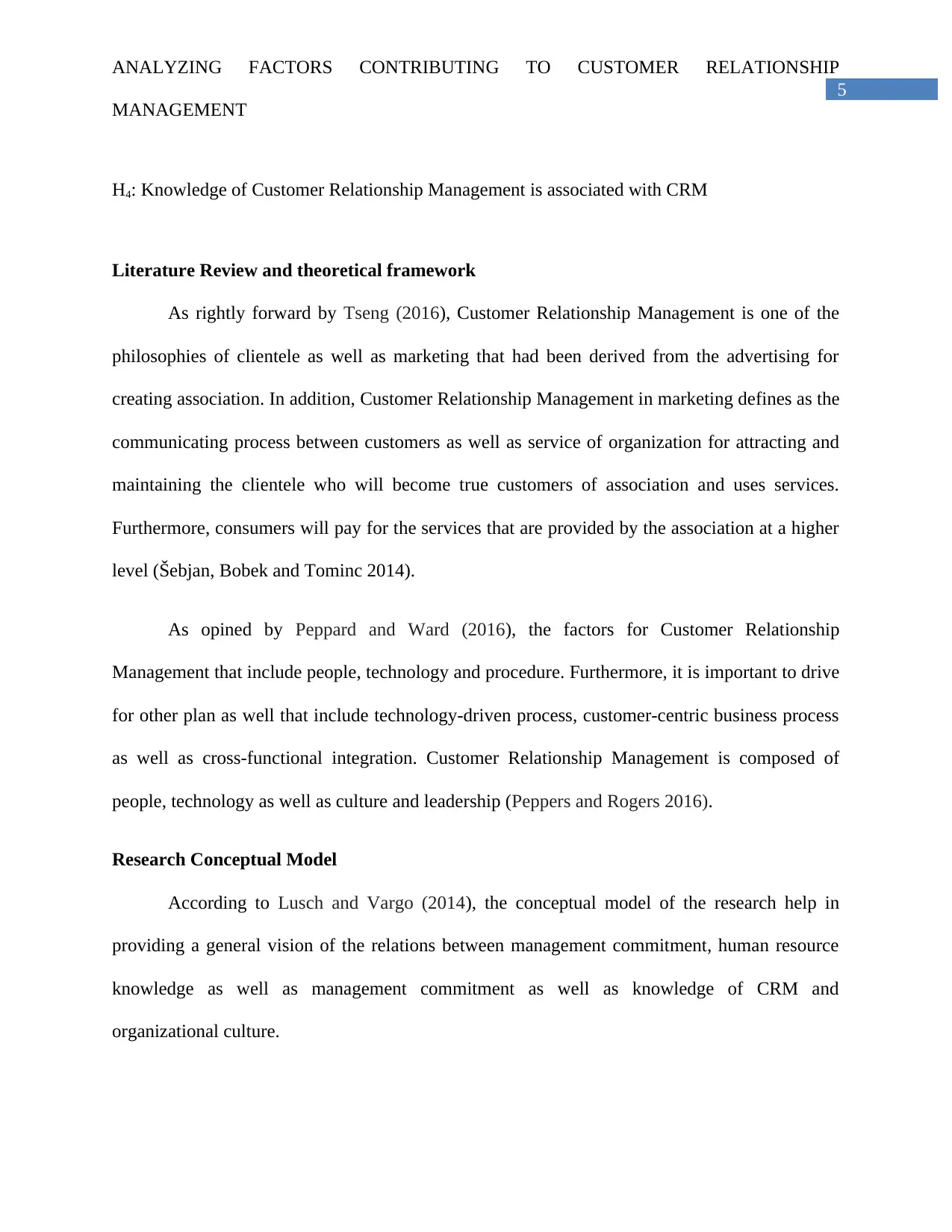
5
ANALYZING FACTORS CONTRIBUTING TO CUSTOMER RELATIONSHIP
MANAGEMENT
H4: Knowledge of Customer Relationship Management is associated with CRM
Literature Review and theoretical framework
As rightly forward by Tseng (2016), Customer Relationship Management is one of the
philosophies of clientele as well as marketing that had been derived from the advertising for
creating association. In addition, Customer Relationship Management in marketing defines as the
communicating process between customers as well as service of organization for attracting and
maintaining the clientele who will become true customers of association and uses services.
Furthermore, consumers will pay for the services that are provided by the association at a higher
level (Šebjan, Bobek and Tominc 2014).
As opined by Peppard and Ward (2016), the factors for Customer Relationship
Management that include people, technology and procedure. Furthermore, it is important to drive
for other plan as well that include technology-driven process, customer-centric business process
as well as cross-functional integration. Customer Relationship Management is composed of
people, technology as well as culture and leadership (Peppers and Rogers 2016).
Research Conceptual Model
According to Lusch and Vargo (2014), the conceptual model of the research help in
providing a general vision of the relations between management commitment, human resource
knowledge as well as management commitment as well as knowledge of CRM and
organizational culture.
ANALYZING FACTORS CONTRIBUTING TO CUSTOMER RELATIONSHIP
MANAGEMENT
H4: Knowledge of Customer Relationship Management is associated with CRM
Literature Review and theoretical framework
As rightly forward by Tseng (2016), Customer Relationship Management is one of the
philosophies of clientele as well as marketing that had been derived from the advertising for
creating association. In addition, Customer Relationship Management in marketing defines as the
communicating process between customers as well as service of organization for attracting and
maintaining the clientele who will become true customers of association and uses services.
Furthermore, consumers will pay for the services that are provided by the association at a higher
level (Šebjan, Bobek and Tominc 2014).
As opined by Peppard and Ward (2016), the factors for Customer Relationship
Management that include people, technology and procedure. Furthermore, it is important to drive
for other plan as well that include technology-driven process, customer-centric business process
as well as cross-functional integration. Customer Relationship Management is composed of
people, technology as well as culture and leadership (Peppers and Rogers 2016).
Research Conceptual Model
According to Lusch and Vargo (2014), the conceptual model of the research help in
providing a general vision of the relations between management commitment, human resource
knowledge as well as management commitment as well as knowledge of CRM and
organizational culture.
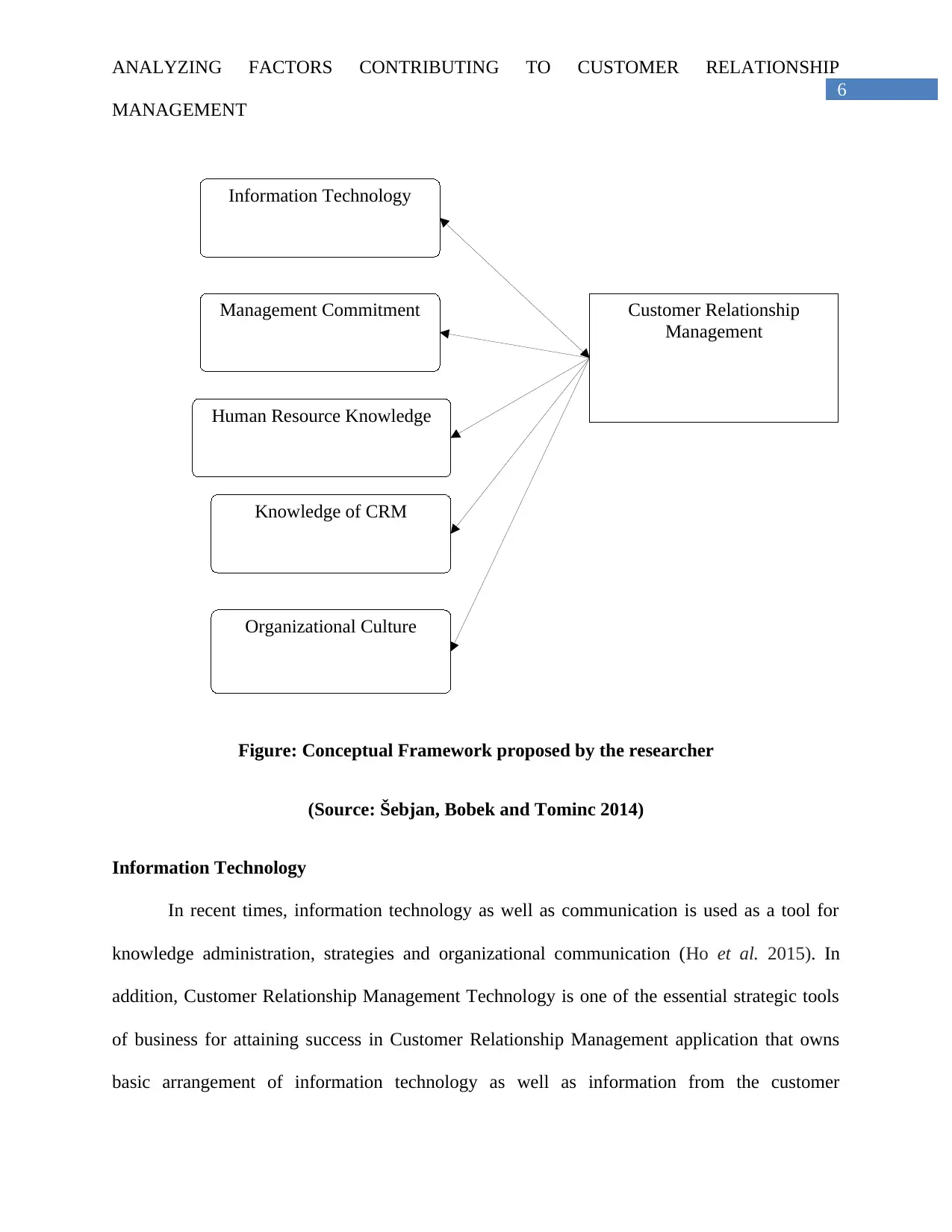
6
Customer Relationship
Management
Information Technology
Management Commitment
Human Resource Knowledge
Knowledge of CRM
Organizational Culture
ANALYZING FACTORS CONTRIBUTING TO CUSTOMER RELATIONSHIP
MANAGEMENT
Figure: Conceptual Framework proposed by the researcher
(Source: Šebjan, Bobek and Tominc 2014)
Information Technology
In recent times, information technology as well as communication is used as a tool for
knowledge administration, strategies and organizational communication (Ho et al. 2015). In
addition, Customer Relationship Management Technology is one of the essential strategic tools
of business for attaining success in Customer Relationship Management application that owns
basic arrangement of information technology as well as information from the customer
Customer Relationship
Management
Information Technology
Management Commitment
Human Resource Knowledge
Knowledge of CRM
Organizational Culture
ANALYZING FACTORS CONTRIBUTING TO CUSTOMER RELATIONSHIP
MANAGEMENT
Figure: Conceptual Framework proposed by the researcher
(Source: Šebjan, Bobek and Tominc 2014)
Information Technology
In recent times, information technology as well as communication is used as a tool for
knowledge administration, strategies and organizational communication (Ho et al. 2015). In
addition, Customer Relationship Management Technology is one of the essential strategic tools
of business for attaining success in Customer Relationship Management application that owns
basic arrangement of information technology as well as information from the customer
⊘ This is a preview!⊘
Do you want full access?
Subscribe today to unlock all pages.

Trusted by 1+ million students worldwide
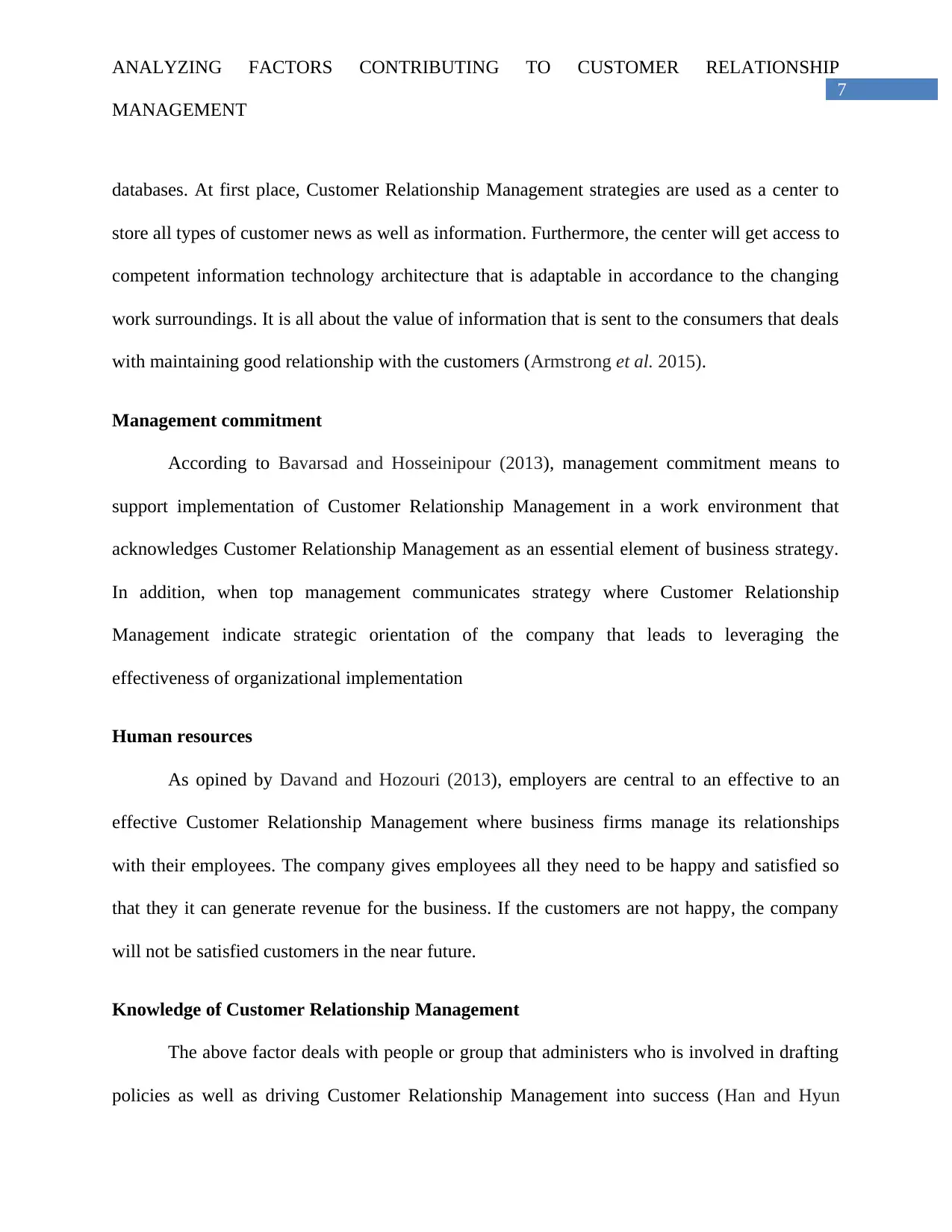
7
ANALYZING FACTORS CONTRIBUTING TO CUSTOMER RELATIONSHIP
MANAGEMENT
databases. At first place, Customer Relationship Management strategies are used as a center to
store all types of customer news as well as information. Furthermore, the center will get access to
competent information technology architecture that is adaptable in accordance to the changing
work surroundings. It is all about the value of information that is sent to the consumers that deals
with maintaining good relationship with the customers (Armstrong et al. 2015).
Management commitment
According to Bavarsad and Hosseinipour (2013), management commitment means to
support implementation of Customer Relationship Management in a work environment that
acknowledges Customer Relationship Management as an essential element of business strategy.
In addition, when top management communicates strategy where Customer Relationship
Management indicate strategic orientation of the company that leads to leveraging the
effectiveness of organizational implementation
Human resources
As opined by Davand and Hozouri (2013), employers are central to an effective to an
effective Customer Relationship Management where business firms manage its relationships
with their employees. The company gives employees all they need to be happy and satisfied so
that they it can generate revenue for the business. If the customers are not happy, the company
will not be satisfied customers in the near future.
Knowledge of Customer Relationship Management
The above factor deals with people or group that administers who is involved in drafting
policies as well as driving Customer Relationship Management into success (Han and Hyun
ANALYZING FACTORS CONTRIBUTING TO CUSTOMER RELATIONSHIP
MANAGEMENT
databases. At first place, Customer Relationship Management strategies are used as a center to
store all types of customer news as well as information. Furthermore, the center will get access to
competent information technology architecture that is adaptable in accordance to the changing
work surroundings. It is all about the value of information that is sent to the consumers that deals
with maintaining good relationship with the customers (Armstrong et al. 2015).
Management commitment
According to Bavarsad and Hosseinipour (2013), management commitment means to
support implementation of Customer Relationship Management in a work environment that
acknowledges Customer Relationship Management as an essential element of business strategy.
In addition, when top management communicates strategy where Customer Relationship
Management indicate strategic orientation of the company that leads to leveraging the
effectiveness of organizational implementation
Human resources
As opined by Davand and Hozouri (2013), employers are central to an effective to an
effective Customer Relationship Management where business firms manage its relationships
with their employees. The company gives employees all they need to be happy and satisfied so
that they it can generate revenue for the business. If the customers are not happy, the company
will not be satisfied customers in the near future.
Knowledge of Customer Relationship Management
The above factor deals with people or group that administers who is involved in drafting
policies as well as driving Customer Relationship Management into success (Han and Hyun
Paraphrase This Document
Need a fresh take? Get an instant paraphrase of this document with our AI Paraphraser
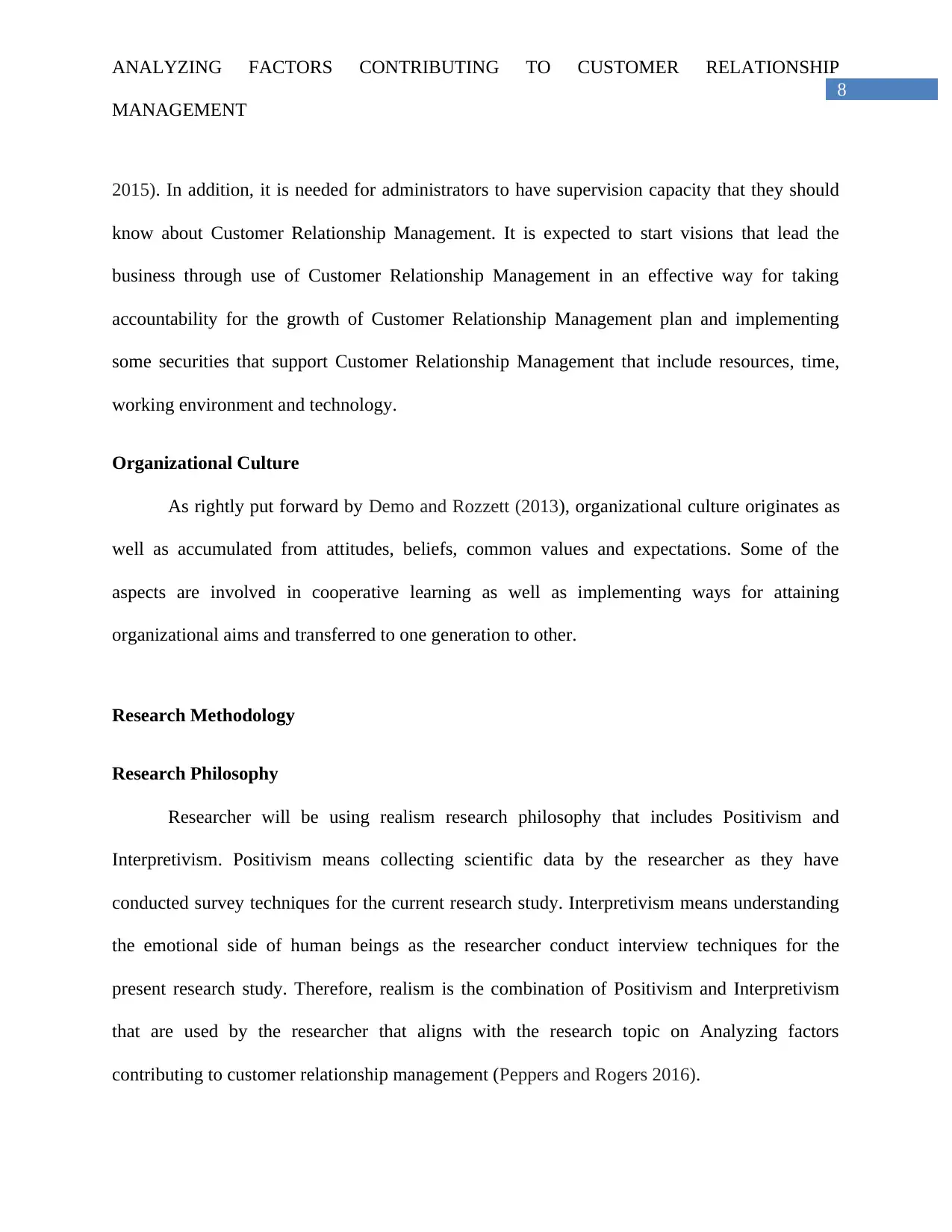
8
ANALYZING FACTORS CONTRIBUTING TO CUSTOMER RELATIONSHIP
MANAGEMENT
2015). In addition, it is needed for administrators to have supervision capacity that they should
know about Customer Relationship Management. It is expected to start visions that lead the
business through use of Customer Relationship Management in an effective way for taking
accountability for the growth of Customer Relationship Management plan and implementing
some securities that support Customer Relationship Management that include resources, time,
working environment and technology.
Organizational Culture
As rightly put forward by Demo and Rozzett (2013), organizational culture originates as
well as accumulated from attitudes, beliefs, common values and expectations. Some of the
aspects are involved in cooperative learning as well as implementing ways for attaining
organizational aims and transferred to one generation to other.
Research Methodology
Research Philosophy
Researcher will be using realism research philosophy that includes Positivism and
Interpretivism. Positivism means collecting scientific data by the researcher as they have
conducted survey techniques for the current research study. Interpretivism means understanding
the emotional side of human beings as the researcher conduct interview techniques for the
present research study. Therefore, realism is the combination of Positivism and Interpretivism
that are used by the researcher that aligns with the research topic on Analyzing factors
contributing to customer relationship management (Peppers and Rogers 2016).
ANALYZING FACTORS CONTRIBUTING TO CUSTOMER RELATIONSHIP
MANAGEMENT
2015). In addition, it is needed for administrators to have supervision capacity that they should
know about Customer Relationship Management. It is expected to start visions that lead the
business through use of Customer Relationship Management in an effective way for taking
accountability for the growth of Customer Relationship Management plan and implementing
some securities that support Customer Relationship Management that include resources, time,
working environment and technology.
Organizational Culture
As rightly put forward by Demo and Rozzett (2013), organizational culture originates as
well as accumulated from attitudes, beliefs, common values and expectations. Some of the
aspects are involved in cooperative learning as well as implementing ways for attaining
organizational aims and transferred to one generation to other.
Research Methodology
Research Philosophy
Researcher will be using realism research philosophy that includes Positivism and
Interpretivism. Positivism means collecting scientific data by the researcher as they have
conducted survey techniques for the current research study. Interpretivism means understanding
the emotional side of human beings as the researcher conduct interview techniques for the
present research study. Therefore, realism is the combination of Positivism and Interpretivism
that are used by the researcher that aligns with the research topic on Analyzing factors
contributing to customer relationship management (Peppers and Rogers 2016).
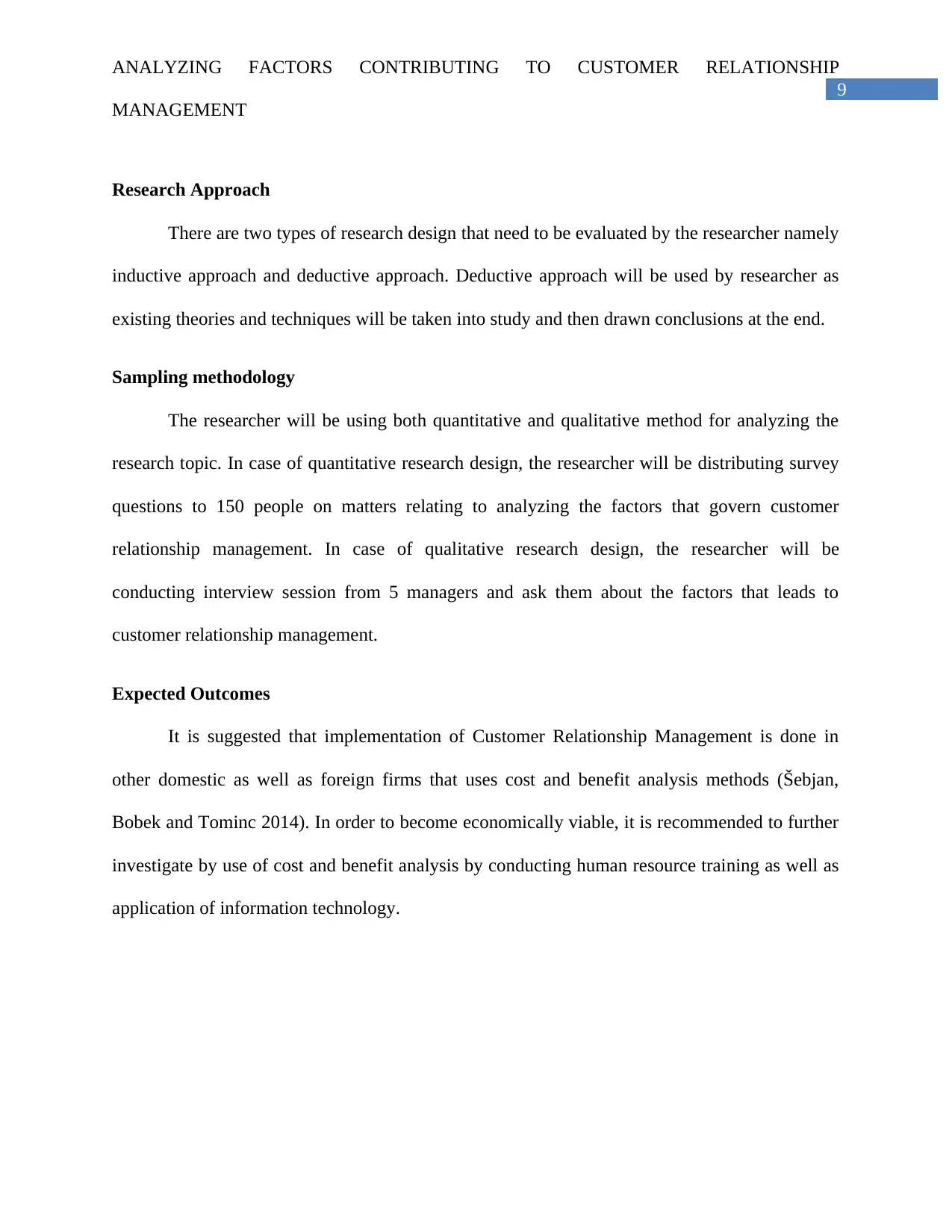
9
ANALYZING FACTORS CONTRIBUTING TO CUSTOMER RELATIONSHIP
MANAGEMENT
Research Approach
There are two types of research design that need to be evaluated by the researcher namely
inductive approach and deductive approach. Deductive approach will be used by researcher as
existing theories and techniques will be taken into study and then drawn conclusions at the end.
Sampling methodology
The researcher will be using both quantitative and qualitative method for analyzing the
research topic. In case of quantitative research design, the researcher will be distributing survey
questions to 150 people on matters relating to analyzing the factors that govern customer
relationship management. In case of qualitative research design, the researcher will be
conducting interview session from 5 managers and ask them about the factors that leads to
customer relationship management.
Expected Outcomes
It is suggested that implementation of Customer Relationship Management is done in
other domestic as well as foreign firms that uses cost and benefit analysis methods (Šebjan,
Bobek and Tominc 2014). In order to become economically viable, it is recommended to further
investigate by use of cost and benefit analysis by conducting human resource training as well as
application of information technology.
ANALYZING FACTORS CONTRIBUTING TO CUSTOMER RELATIONSHIP
MANAGEMENT
Research Approach
There are two types of research design that need to be evaluated by the researcher namely
inductive approach and deductive approach. Deductive approach will be used by researcher as
existing theories and techniques will be taken into study and then drawn conclusions at the end.
Sampling methodology
The researcher will be using both quantitative and qualitative method for analyzing the
research topic. In case of quantitative research design, the researcher will be distributing survey
questions to 150 people on matters relating to analyzing the factors that govern customer
relationship management. In case of qualitative research design, the researcher will be
conducting interview session from 5 managers and ask them about the factors that leads to
customer relationship management.
Expected Outcomes
It is suggested that implementation of Customer Relationship Management is done in
other domestic as well as foreign firms that uses cost and benefit analysis methods (Šebjan,
Bobek and Tominc 2014). In order to become economically viable, it is recommended to further
investigate by use of cost and benefit analysis by conducting human resource training as well as
application of information technology.
⊘ This is a preview!⊘
Do you want full access?
Subscribe today to unlock all pages.

Trusted by 1+ million students worldwide
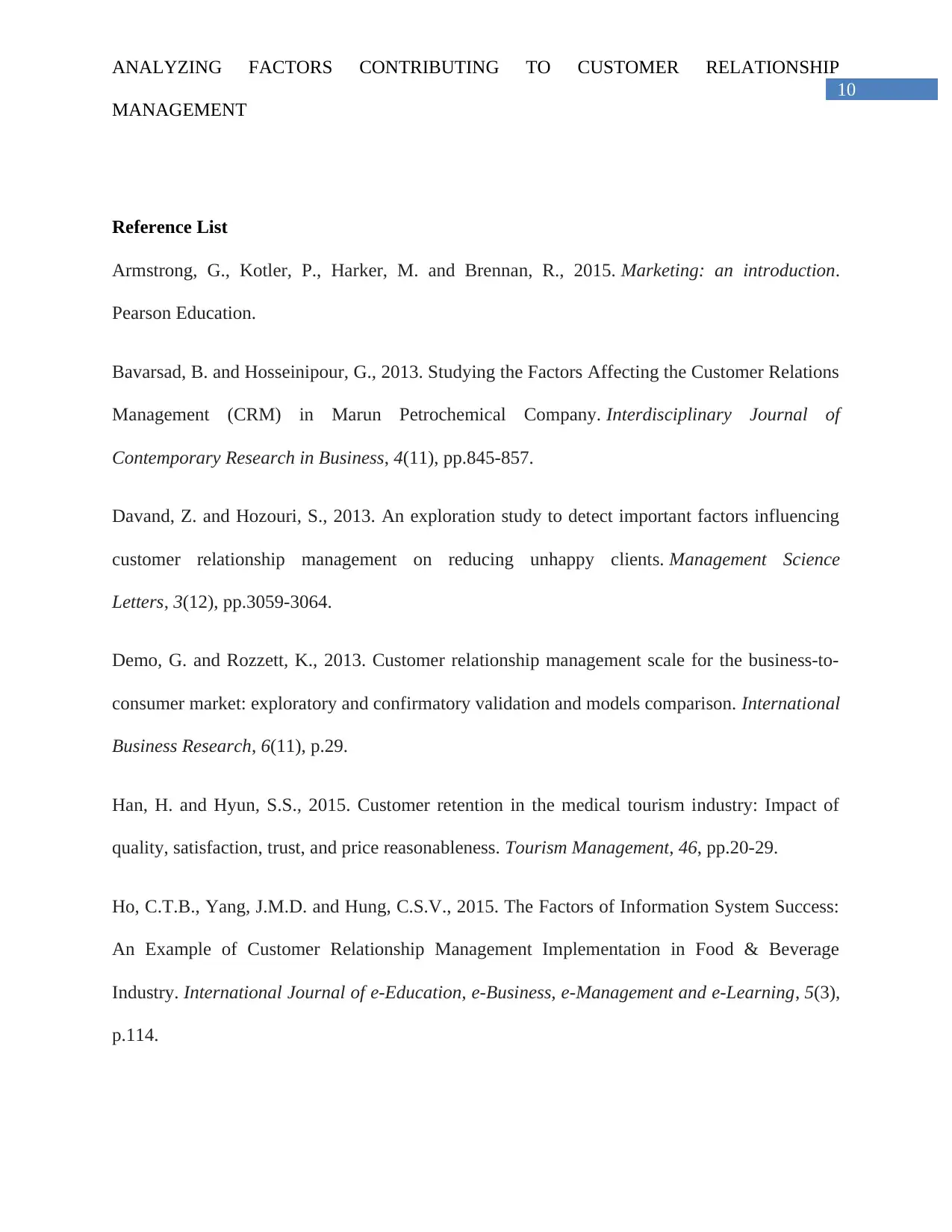
10
ANALYZING FACTORS CONTRIBUTING TO CUSTOMER RELATIONSHIP
MANAGEMENT
Reference List
Armstrong, G., Kotler, P., Harker, M. and Brennan, R., 2015. Marketing: an introduction.
Pearson Education.
Bavarsad, B. and Hosseinipour, G., 2013. Studying the Factors Affecting the Customer Relations
Management (CRM) in Marun Petrochemical Company. Interdisciplinary Journal of
Contemporary Research in Business, 4(11), pp.845-857.
Davand, Z. and Hozouri, S., 2013. An exploration study to detect important factors influencing
customer relationship management on reducing unhappy clients. Management Science
Letters, 3(12), pp.3059-3064.
Demo, G. and Rozzett, K., 2013. Customer relationship management scale for the business-to-
consumer market: exploratory and confirmatory validation and models comparison. International
Business Research, 6(11), p.29.
Han, H. and Hyun, S.S., 2015. Customer retention in the medical tourism industry: Impact of
quality, satisfaction, trust, and price reasonableness. Tourism Management, 46, pp.20-29.
Ho, C.T.B., Yang, J.M.D. and Hung, C.S.V., 2015. The Factors of Information System Success:
An Example of Customer Relationship Management Implementation in Food & Beverage
Industry. International Journal of e-Education, e-Business, e-Management and e-Learning, 5(3),
p.114.
ANALYZING FACTORS CONTRIBUTING TO CUSTOMER RELATIONSHIP
MANAGEMENT
Reference List
Armstrong, G., Kotler, P., Harker, M. and Brennan, R., 2015. Marketing: an introduction.
Pearson Education.
Bavarsad, B. and Hosseinipour, G., 2013. Studying the Factors Affecting the Customer Relations
Management (CRM) in Marun Petrochemical Company. Interdisciplinary Journal of
Contemporary Research in Business, 4(11), pp.845-857.
Davand, Z. and Hozouri, S., 2013. An exploration study to detect important factors influencing
customer relationship management on reducing unhappy clients. Management Science
Letters, 3(12), pp.3059-3064.
Demo, G. and Rozzett, K., 2013. Customer relationship management scale for the business-to-
consumer market: exploratory and confirmatory validation and models comparison. International
Business Research, 6(11), p.29.
Han, H. and Hyun, S.S., 2015. Customer retention in the medical tourism industry: Impact of
quality, satisfaction, trust, and price reasonableness. Tourism Management, 46, pp.20-29.
Ho, C.T.B., Yang, J.M.D. and Hung, C.S.V., 2015. The Factors of Information System Success:
An Example of Customer Relationship Management Implementation in Food & Beverage
Industry. International Journal of e-Education, e-Business, e-Management and e-Learning, 5(3),
p.114.
Paraphrase This Document
Need a fresh take? Get an instant paraphrase of this document with our AI Paraphraser
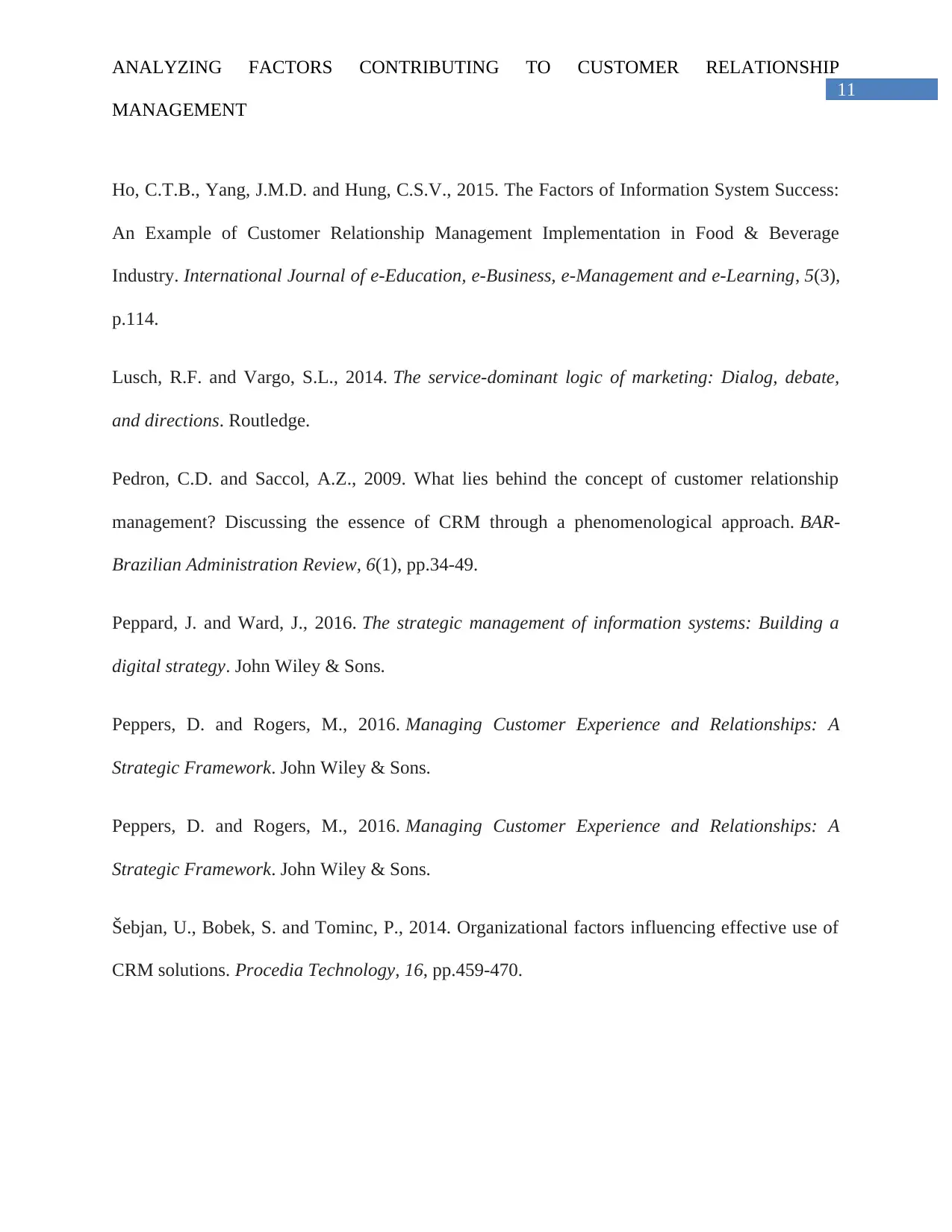
11
ANALYZING FACTORS CONTRIBUTING TO CUSTOMER RELATIONSHIP
MANAGEMENT
Ho, C.T.B., Yang, J.M.D. and Hung, C.S.V., 2015. The Factors of Information System Success:
An Example of Customer Relationship Management Implementation in Food & Beverage
Industry. International Journal of e-Education, e-Business, e-Management and e-Learning, 5(3),
p.114.
Lusch, R.F. and Vargo, S.L., 2014. The service-dominant logic of marketing: Dialog, debate,
and directions. Routledge.
Pedron, C.D. and Saccol, A.Z., 2009. What lies behind the concept of customer relationship
management? Discussing the essence of CRM through a phenomenological approach. BAR-
Brazilian Administration Review, 6(1), pp.34-49.
Peppard, J. and Ward, J., 2016. The strategic management of information systems: Building a
digital strategy. John Wiley & Sons.
Peppers, D. and Rogers, M., 2016. Managing Customer Experience and Relationships: A
Strategic Framework. John Wiley & Sons.
Peppers, D. and Rogers, M., 2016. Managing Customer Experience and Relationships: A
Strategic Framework. John Wiley & Sons.
Šebjan, U., Bobek, S. and Tominc, P., 2014. Organizational factors influencing effective use of
CRM solutions. Procedia Technology, 16, pp.459-470.
ANALYZING FACTORS CONTRIBUTING TO CUSTOMER RELATIONSHIP
MANAGEMENT
Ho, C.T.B., Yang, J.M.D. and Hung, C.S.V., 2015. The Factors of Information System Success:
An Example of Customer Relationship Management Implementation in Food & Beverage
Industry. International Journal of e-Education, e-Business, e-Management and e-Learning, 5(3),
p.114.
Lusch, R.F. and Vargo, S.L., 2014. The service-dominant logic of marketing: Dialog, debate,
and directions. Routledge.
Pedron, C.D. and Saccol, A.Z., 2009. What lies behind the concept of customer relationship
management? Discussing the essence of CRM through a phenomenological approach. BAR-
Brazilian Administration Review, 6(1), pp.34-49.
Peppard, J. and Ward, J., 2016. The strategic management of information systems: Building a
digital strategy. John Wiley & Sons.
Peppers, D. and Rogers, M., 2016. Managing Customer Experience and Relationships: A
Strategic Framework. John Wiley & Sons.
Peppers, D. and Rogers, M., 2016. Managing Customer Experience and Relationships: A
Strategic Framework. John Wiley & Sons.
Šebjan, U., Bobek, S. and Tominc, P., 2014. Organizational factors influencing effective use of
CRM solutions. Procedia Technology, 16, pp.459-470.
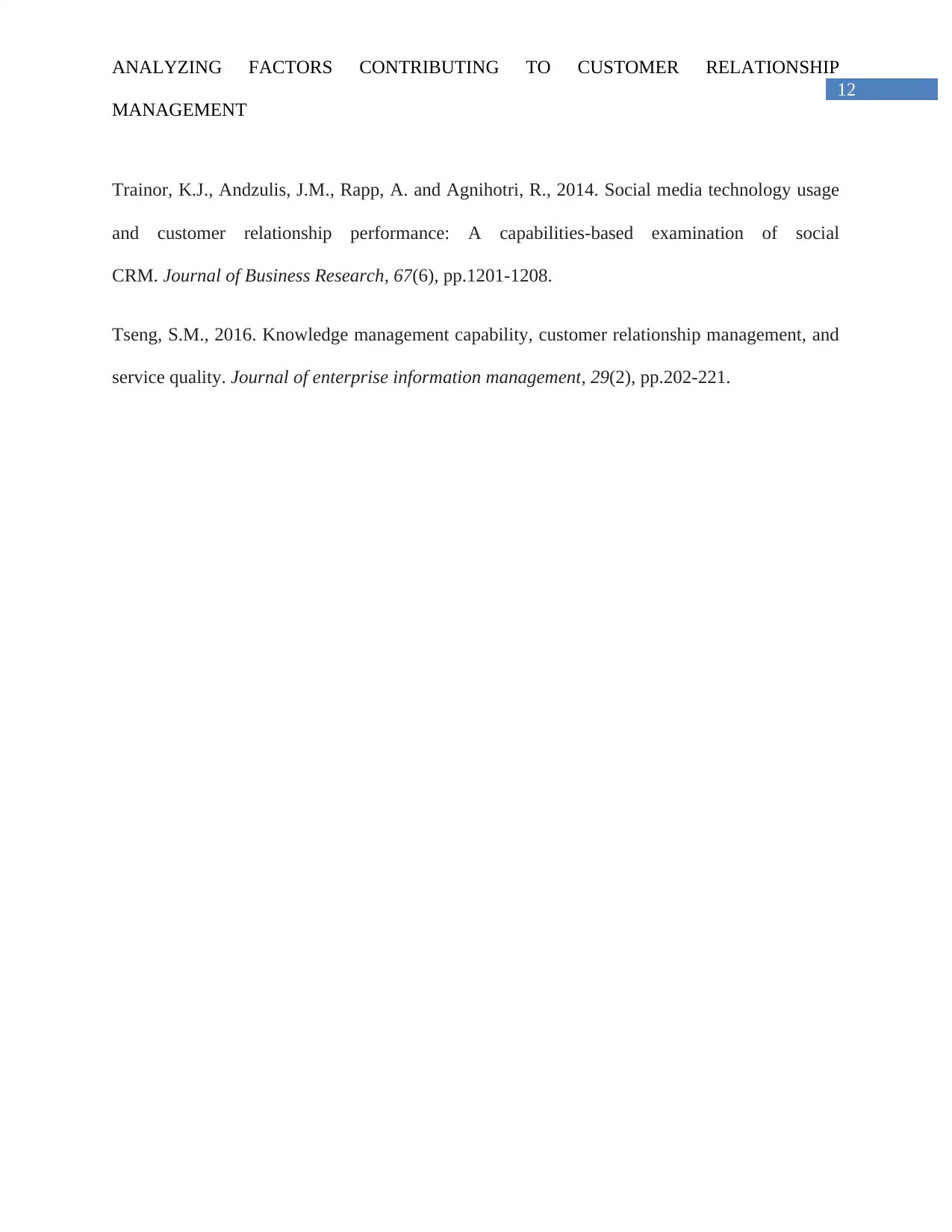
12
ANALYZING FACTORS CONTRIBUTING TO CUSTOMER RELATIONSHIP
MANAGEMENT
Trainor, K.J., Andzulis, J.M., Rapp, A. and Agnihotri, R., 2014. Social media technology usage
and customer relationship performance: A capabilities-based examination of social
CRM. Journal of Business Research, 67(6), pp.1201-1208.
Tseng, S.M., 2016. Knowledge management capability, customer relationship management, and
service quality. Journal of enterprise information management, 29(2), pp.202-221.
ANALYZING FACTORS CONTRIBUTING TO CUSTOMER RELATIONSHIP
MANAGEMENT
Trainor, K.J., Andzulis, J.M., Rapp, A. and Agnihotri, R., 2014. Social media technology usage
and customer relationship performance: A capabilities-based examination of social
CRM. Journal of Business Research, 67(6), pp.1201-1208.
Tseng, S.M., 2016. Knowledge management capability, customer relationship management, and
service quality. Journal of enterprise information management, 29(2), pp.202-221.
⊘ This is a preview!⊘
Do you want full access?
Subscribe today to unlock all pages.

Trusted by 1+ million students worldwide
1 out of 12
Related Documents
Your All-in-One AI-Powered Toolkit for Academic Success.
+13062052269
info@desklib.com
Available 24*7 on WhatsApp / Email
![[object Object]](/_next/static/media/star-bottom.7253800d.svg)
Unlock your academic potential
Copyright © 2020–2025 A2Z Services. All Rights Reserved. Developed and managed by ZUCOL.





